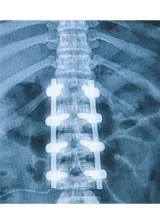
If you’re headed for back surgery, there may be a way to get a leg-up on a faster, less painful recovery.
Tufts Medical Center’s Spine Center has become one of the few places regionally to administer a numbing medicine during a common type of back surgery – minimally invasive spinal fusion.
“It’s one of the most common procedures we do here,” said James Kryzanski, MD, Co-Chief of the Division of Spinal Surgery at Tufts Medical Center, noting his team completes three to four spinal fusions each week. “The incision is usually small so it lends itself toward this type of treatment that numbs the area and keeps it numb for a few days.”
About spinal fusion
Spinal fusion is a procedure where two or more vertebrae are “welded” together to strengthen the spine and prevent motion in areas of pain. Abigail Eldridge-Nickerson knows the surgery well. After four years of trying everything from physical therapy to cortisone injections to deal with her sciatica, she had parts of her spine fused together to eliminate the discomfort.
“I couldn’t feel my left foot. The pain would run down my leg and I couldn’t walk, couldn’t sleep and couldn’t stand for long periods of time at work,” said Abigail, who lives on Cape Cod. “I got referred to Tufts Medical Center and 30 days later I had surgery which gave me my life back.”
Tufts MC surgeons have embraced a unique approach to pain control during spinal fusion– an added step where a dose of a non-narcotic analgesic called liposomal bupivacaine is injected into the muscles around the incision area, just as the surgery is being completed.
“It numbs the area like Novacaine does for dental procedures, but works for a longer period of time. The medication is encapsulated in microscopic spheres that release the drug over time,” said Ron Riesenburger, MD, Director of the Spine Center at Tufts Medical Center. “It wears off slowly, over the first 24-48 hours after surgery and it relieves the pain of the incision, which can be quite intense post-procedure.”
Study of injections on pain control
Drs. Riesenburger and Kryzanski, along with anesthesiology colleagues tested the effectiveness of the injections on pain control using 74 patients – half who received the drug with their spinal fusion and half who did not. They found that on average, those who had the medication had a 20 percent pain reduction in the 24 hours following the procedure and required 33 percent less narcotic medication. Their results are published in the July 2016 edition of World Neurosurgery.
“Patients who have narcotics for their pain management are slower to mobilize after surgery and these drugs can cause a host of side effects including vomiting, constipation and sleepiness.” said Dr. Kryzanski. “This injection is not a narcotic and the medicine is placed right at the site of the pain.”
“Importantly, we also found patients who had the injection lessened their hospital stay by about a day,” said Dr. Riesenburger, who was senior author on the study. “Not only do patients get home or into rehabilitation faster, taking this simple step saves the healthcare system money.”
Spinal fusions most often involve people over 40 who end up with painful degenerative diseases of the spine as they age. And the procedures are on the rise as the population of baby boomers has become older. From 2001 and 2011, spinal fusions increased by 70 percent in the United States.
Abigail believes the use of the medication helped her on her road to recovery.
“The first day my nurse asked me if I wanted to wash my face and when I said ‘yes,’ she helped me get up and walk over to the sink,” she recalled. “I had no pain that day. And six weeks later I was back to work.”
“A lot more patients are in need of these types of surgeries in order to lead a good quality of life into their 70s, 80s and beyond,” said Dr. Riesenburger. “This is one small thing we can do to help them get back on their feet quicker.”
To make an appointment at the Spine Center at Tufts Medical Center, call 617.636.2266 Monday – Friday, 8 am – 4:30 pm.
The above content is provided for educational purposes by Tufts Medical Center. It is free for educational use. For information about your own health, contact your physician.